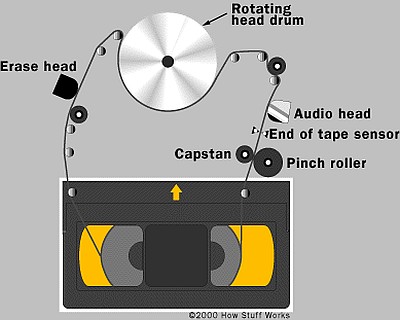The VCR marks one of the most important events in the history of TV because, for the first time, it gave people control of what they could watch on their TV sets. Prior to the VCR, there was no such thing as a video store, and when you consider that there is now a video store on nearly every street corner in the United States, you can see what a big impact the VCR has had!
The other interesting thing about VCRs is how incredibly intricate and interesting they are inside. They are certainly the most complex mechanical systems most people own outside of their automobiles, yet VCRs can cost as little as $75! There are motorized tape loading and ejection systems, complex motorized tape paths, drum-mounted rotating read/record heads… VCRs really are neat inside!
In this article, we will look inside a VCR to understand the basics of its operation, both from a tape transport standpoint and a signal standpoint. Once you have seen what is going on, you will be both amazed and impressed!
The VCR Tape
A VCR tape is pretty intricate device in its own right, and it’s a classic miracle of mass production. It is amazing what you can buy for $2!
If you take a video tape apart, you will find that it contains:
- The top and bottom pieces of the outer shell
- A moving, spring-loaded door to protect the tape
- Two spools to hold the tape
-
- An 800-foot (244-m) long, 1/2-inch (1.3-cm) wide piece of oxide-coated Mylar tape that acts as the recording medium
- Several low-friction rollers to guide the tape across the front of the shell
- Two spring-loaded locks to prevent the tape from unrolling inside the cassette
- Several screws to hold the whole thing together
When the tape is inserted into a VCR, the VCR uses a lever to release and open the door, exposing the tape. It also inserts a pin into the hole to disengage the two locks on the spools. At that point, the drive can extract the tape and play it.
The VCR
In 1956, the first commercial reel-to-reel videotape recorder was created by Charles Ginsburg and Ray Dolby while working for the Ampex Corporation. This new device was a major development for television broadcasters because it marked the first time that shows could be recorded and broadcast later. Prior to 1956, all shows on television were live.
Sony created the first inexpensive VCR in 1969. In 1976, the VHS tape format appeared and began its domination of the market. Video stores were soon to follow. Blockbuster opened its first video store in Dallas, TX, in October 1985, and now has over 8,000 stores.
The VCR itself has two jobs:
- It must deal with the tape — an extremely thin, fairly fragile and incredibly long piece of plastic. As we will see in a moment, it is amazing what a VCR does with the tape.
- It must read the signals off of the tape and convert them to signals that a TV can understand.
Both of these are formidable tasks, and the second one was a big technological challenge. In sound recording, the sound information is stored linearly on the tape. That is, the tape moves past the recording head and the sound information is laid down as a long line following the length of the tape. The tape might move past the head at a speed of 2 or 3 inches (5 – 8 cm) per second. A video signal contains perhaps 500 times more information than a sound signal, so the same approach cannot work. The tape would have to be moving past the head at a rate of many feet per second.
For more Detail: How VCRs Work

